Without fail, it happens every year. As winter weather starts to wear us all down, the number of claims for two preventable losses come pouring in: water damage from frozen pipes and roof collapses from snow accumulation.
They’re common claims because they’re weather-specific and it can be difficult to judge when intervention is required before a problem arises.
We’re sharing what causes these two common property losses and how you can prevent them in your commercial building.
Preventing water damage from burst pipes
As temperatures drop in the winter months, it’s critical to ensure a commercial building is adequately heated so that pipes don’t freeze and burst.
While most building managers ensure high-traffic zones have regulated temperatures, it’s easy to forget about rarely used areas, such as attics, external stairwells, and technical rooms. These are generally the types of places where damage from frozen pipes originate.
The ensuing water damage can be catastrophic for any business. Water damage is especially difficult to remediate and can create extensive damage that can lead to lengthy repairs. In some cases, damage is missed and needs to be corrected years later. If buildings are older and asbestos is in the walls, you can expect added downtime and higher expenses for an already costly loss.
There are preventative measures you can take to mitigate the risk in areas that aren’t as well insulated or don’t require as much heat as elsewhere in the building.
- Add a remote thermometer and monitor the temperature in areas where people don’t go every day. The National Fire Protection Association (NFPA) recommends maintaining a minimum temperature of 4°C for wet pipe sprinkler systems.
- Use a digital alarm that will alert you if the temperature dips below the minimum set temperature.
- Install heat trace cables or other local heating units for pipes in less insulated areas. They can help keep the temperature of the pipes controlled at a specific temperature. The NFPA suggest adding local heating units where temperature is known to dip below the 4°C threshold.
For construction projects not yet fully enclosed and subject to weather, maximize daylight hours by starting work early, use space heaters safely for temporary heating, monitor temperatures in areas where pipes and pumps may be subject to freezing, and stay informed by regularly checking weather forecasts and having backup plans for severe weather.
Preventing roof collapses from snow accumulation
By February or March, claims from roof collapses become increasingly common. After a few months of alternating snowfalls and melting periods, layers of dense ice can build up and add a lot of weight to commercial rooftops.
Roof collapses are most typical in older buildings, agricultural wood frames, and outbuildings without robust superstructure, as well as additions on existing buildings that weren’t built to code. Snow tends to particularly amass in areas of a roof where there are junctions and parapets.
Newer commercial buildings are usually designed and built adhering to the National Building Code of Canada. These standards consider the annual precipitation in an area and recommend a design built to withstand it.
Even if your building is older and you live in an area with a lot of annual snowfall, you can mitigate the risk of roof collapse.
- Know your roof’s load limit. Remove snow accumulations from the roof before the snow reaches 50% of the “safe” maximum depth.
- Include roof maintenance in your snow removal plan. Ensure that staff are trained to safely access the roof during winter and remove snow regularly without damaging membranes on the roof. Or, if you have a snow removal contractor, make it part of their mandate to maintain the roof during winter.
- Install heat trace cables to prevent accumulation of ice on your rooftop.
Resources on maintaining your property in winter
- Winterize your property to prevent costly problems, Aviva Risk Management Solutions
- Why your building needs a water mitigation plan, Aviva Risk Management Solutions
- Reducing the risk of commercial roof collapse, Insurance Institute
- Managing changing snow load risks for buildings in Canada’s north, Canada in a Changing Climate
Get expert support
Aviva Risk Management Solutions has risk consultants across Canada to provide our customers with advice and resources. Reach out to us at mailto:arms.canada@aviva.com.













